
|
The Right Stuff (1983)
In director Philip Kaufman's epic dramatic adaptation
of Tom Wolfe's best-selling non-fiction novel about military pilots
conducting tests and research at Edwards Air Force Base (California),
and the test pilots (future astronauts) involved in the pioneering Project
Mercury spaceflight program
- with many exhilarating flying sequences and a brilliant Bill Conti
score:
- the opening scene with voice-over narration about
the goal of breaking the sound barrier in the late 1940s: "There
was a demon that lived in the air. They said whoever challenged
him would die. Their controls would freeze up, their planes would
buffet wildly, and they would disintegrate. The demon lived at
Mach 1 on the meter, seven hundred and fifty miles an hour, where
the air could no longer move out of the way. He lived behind a
barrier through which they said no man could ever pass. They called
it the sound barrier. Then they built a small plane, the X-1,
to try and break the sound barrier. And men came to the high desert
of California to ride it. They were called test pilots and no
one knew their names"
- the secret
test mission sequences, set in 1947 at an army airfield in California
(Muroc, the future site of Edwards AF base), of obsessed, 'right
stuff' test pilot Chuck
Yeager (Oscar-nominated Sam Shepard); in the local bar, Yeager
was approached by two military officials
and casually
asked what he truly thought of the sound barrier - he responded: "Well,
I'll tell ya half these engineers have never been off the ground,
ya know. I mean, they're liable to tell ya that the sound barrier's
a brick wall in the sky. It'll rip your ears off if you try to
go through it. If you ask me, I don't believe the damn thing even
exists";
he agreed to "have a go at it" and fly the next morning - with
no additional salary beyond his $283 dollars a month pay from the
Air Force
- the sequence of Yeager's attempt
to break the sound barrier - his top-secret, successful
test run in October of 1947; just before Yeager took off in a B-29
bomber, he kissed and then waved goodbye to his wife Glennis (Barbara
Hershey), who stood nearby to watch; onboard, Yeager was dropped
from a B-29 in his high-speed, rocket-powered orange Bell X-1 aircraft,
and after some tense moments, he broke the sound barrier - his
plane began to shake and vibrate, his pressure gauge cracked
and others on the ground felt the impact of the sonic boom - they
asked themselves: "What's that sound?"; some moaned: "Oh
God, he bought the farm. That's it, we're back to square one" -
fearing Yeager's death; however, Yeager suddenly reported via radio: "Make
a note here would ya? Must be something wrong
with this ol' Mach meter. Jumped plumb off the scale. Gone kinda
screwy on me... I'm still goin' upstairs like a bat outta hell";
the observers were jubilant ("He finally did it! He broke the
sound barrier!"), including his wife Glennis and friends
Slick Goodlin (William Russ) and Pancho Barnes (Kim Stanley) (proprietess
of the flyboys' local watering hold in the Mojave, the Happy Bottom
Riding Club)
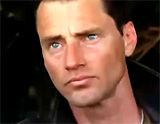
|
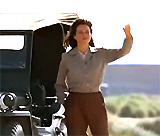
|

|
|
Chuck Yeager (Sam Shepard)
|
Glennis Yeager (Barbara Hershey) Waving Goodbye
|
Yeager's X-1 Dropped from B-29
|
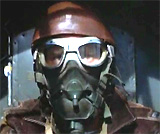
|
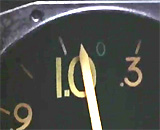
|
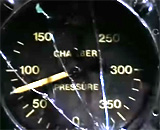
|
|
Yeager at the Controls
|
Gauges Showing Mach 1.0 Speed Broken
|
Pressure Gauge Cracked
|
- the vignette from 1953 when one
of the first future astronauts, boyish USAF pilot Capt. Gordon
Cooper (Dennis Quaid) and pretty wife Trudy (Pamela Reed) drove
in an open convertible toward Edwards AF base, with the radio blaring:
"I've got a rocket in my pocket"; he bragged as he zoomed past
a truck: "Who's
the best pilot you ever saw? You're lookin' at it, baby....Did
I ever let you down?";
she was soon completely let down by the disappointing and sparse
military base accommodations - with dirty tap water, lack of electricity
- and the fear of losing her husband in a crash, etc.
- after the launch of Russia's satellite dubbed Sputnik
into space in 1957 (orbiting for three weeks), a 'space race' was
triggered and the NASA agency was formed; a number of failed rocket
launchings were conducted in the next few years at Cape Canaveral
in Florida
- naval
officer Alan Shepard (Scott Glenn) was introduced after landing
his jet on an aircraft carrier; he had been noticed on TV's The
Ed Sullivan Show (and on a game show) by two sea-sick NASA
recruiters (Harry Shearer and Jeff Goldblum) who decided to approach
him on the carrier; the
two spoke of the dangers of space flight to Shepard: ("I doubt
you've heard about our project. We're going up against the Russians
all the way. It's got the highest priority. It's a hazardous undertaking.
In fact, it's extremely hazardous, if you get my meaning. It's
so hazardous that if you decide not to volunteer, it will not be
held against you in any way"); without hesitating, Shepard
immediately signed on: "Count me in"
- the scenes of the many medical exams and physical
tests endured by the pilots chosen as applicants for the Mercury space
program, including centrifugal force tests
and enema continence tests, followed by extreme fitness and training
exercises; at the Lovelace Clinic (Albuquerque NM) in February
of 1959, Shepard was given a paralyzing nerve stimulation test
in his left arm

|
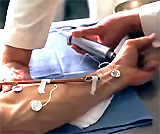
|

|
|
Spinning and Centrifugal Force Test
|
Puncture and Nerve Test
|
Enema Continence Test
|
- the scene of the lung capacity test during a rigorous
selection process, when the prospective astronaut-trainees were
instructed by the head Nurse Murch (Jane Dornacker) to exhale continuously
into a tube and keep a ping-pong ball positioned between two sets
of lines; she mentioned that the current record was 91 seconds;
thinking that he was the record-breaking winner, Gordon Cooper
boasted: "93 seconds. Read it and weep," but then noticed two
others still taking the test, Marine flyer John Glenn (Ed Harris)
and Scott Carpenter (Charles Frank) - Carpenter lasted the
longest; Virgil "Gus" Grissom (Fred Ward) joked to Cooper about
the last two contestants: "We were competing with Archie and Jughead"
- the publicity scene of the seven,
hand-picked pioneering Project Mercury astronauts being introduced
one-by-one by NASA to cheers and praise, and the launching of a subsequent
promotional and photo campaign to portray them as heroes (with their
wives)
- during the earliest test flights - the use of chimpanzees
to test G-forces and
other effects upon animal life, and the controversy that developed
over using them as flight subjects, passengers or substitute 'astronauts'
- the scene of the chosen Mercury astronauts
(including John Glenn and Alan Shepard), inspecting and confronting
the team of white-coated NASA scientists/engineers led by a German-accented
chief (Scott Beach) (modeled after on immigrant Wernher von Braun);
they asked intelligent questions (unlike chimpanzees) about their
small and inadequate flight capsule - quering about its lack of
a window or an escape hatch with explosive emergency bolts; Gordon
Cooper asked: "Do you boys know what makes this bird go
up? Funding makes this bird go up!", and then "Gus" Grissom
stepped forward and added that required design advances demanded
more funding (they threatened to reveal funding issues with the
press clamoring just outside the hangar): "That's right. No
bucks, no Buck Rogers"
- after making their point, the seven astronauts
("pilots") lined up in front of the capsule ("spacecraft") to have
publicity photos taken by the eager press - seen in a montage of
different poses (all vying for attention)
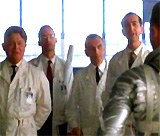
|

|
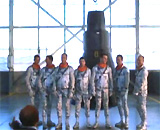
|
Mercury Astronauts Confronting Engineers/Scientists
Led by 'Wernher von Braun'
|

|

|
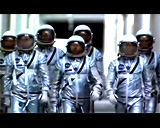
|
|
Historic Footage of JFK
|
The Iconic Images of the Seven Mercury Astronauts
Walking Forward Toward the Launch Pad
|
- the scene of Alan Shepard's flight into space -
becoming the first American to be successfully launched in May
of 1961 - he was strapped into the capsule and prepared to launch
for a short 15-minute orbital flight; however, there were numerous
glitches and delays, as reported by Eric Sevareid (as Himself):
"There's another hold from NASA, another delay. Alan Shepard
sits there, patiently waiting. What can be going through a man's
mind at this moment?" - actually, Shepard was naturally complaining
of a full bladder to ground control: ("Gordo, I have to urinate....Request
permission to relieve bladder") and was permitted to pee into
his suit: ("Permission to wet your diapers anytime, son")
- to everyone's embarrassment; then Shepard asserted: "Well,
I'm a wetback now.... I'm cooler than you are. Why don't you fix your little problems and
light this candle!"
- the sequence of John Glenn's launch by a Mercury Atlas
rocket in February 1962 - becoming the first American to orbit
the Earth (three times) - and his harrowing re-entry with a faulty
and loose heat shield on his capsule - he survived the 18,000 miles
per hour and heat build-up during his return (humming to curb his
anxiety), with a short nerve-wracking period of time when his radio
blanked out during ionization; he was celebrated with a ticker-tape
parade up New York's Fifth Avenue
- there were continuing tests at the rival Edwards
AF base, where the Mercury program was mocked by test pilot
Chuck Yeager ("Anybody that goes up in the damn thing is gonna
be Spam in a can"); however, Yeager also recognized the incredible
bravery required to be a Mercury astronaut: "Monkeys? You think
a monkey knows he's sittin' on top of a rocket that might explode?
These astronaut boys they know that, see? Well, I'll tell you something,
it takes a special kind of man to volunteer for a suicide mission,
especially one that's on TV. Ol' Gus, he did all right"
- in a frightening, expertly-edited sequence, Yeager
took a dangerous, high-altitude, record-attempting flight in a
specially modified Lockheed F-104 Starfighter jet; at the edge
of space, his completely-vertical plane stalled and he lost control,
and the doomed aircraft quickly lost altitude (exhibited by a
wildly-revolving altitude gauge) - Yeager was able to push his
ejection-seat button, but his flight suit was set on fire by the
rocket in the ejection seat, and a trail of smoke was viewed behind
him (his helmet was on fire); the plane precipitously descended
and crashed into the desert
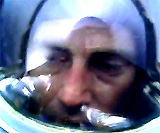
|
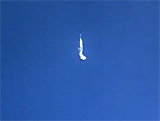
|
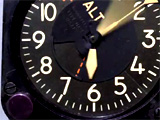
|
|
Yeager in His Flight Suit
|
Yeager's Vertical High-Altitude Flight
|
Altitude Gauge Spinning
|
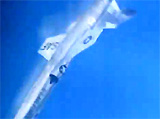
|

|

|
|
Plane Went Out of Control and Spun
|
Yeager Ejecting
|
Flames From Ejection Seat
|

|
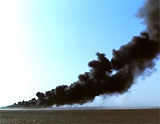
|

|
|
Yeager's Helmet Burning
|
Crashed, Smoking Plane
|
Yeager Burned But Alive
|
- miraculously, Yeager had survived the high-speed
ejection but was badly charred and burned - there was the iconic
sight of him proudly walking away from the wreckage of his plane
smoldering behind him, with his parachute in his arms
- the sequence of celebration for the heroic
astronauts by Vice-President Lyndon Baines Johnson (Donald Moffat)
in the Houston Astrodome - with a Texas-sized banquet and a striptease
stage performance by 60 year-old burlesque dancer Sally Rand (Peggy
Davis) who waved giant white feathered wings serving as fans to
mostly obscure her nakedness
- in the concluding scene - Gordo Cooper finally
had a chance to prove he was "the best pilot you ever saw" -
by becoming the astronaut with the longest space flight to date in
May of 1963; it was the last flight of the Mercury program;
as his spacecraft ascended nosily into the heavens, his voice quivered
as he reported back: "Up we go into the wild blue yonder. Thirty
seconds and fuel is go, oxygen is go. Cabin pressure on the top
peg. Altimeter is working.The sun is coming through the window. Oh,
Lord, what a heavenly light" - a smile broke over his face
- the film's ending (voice-over) narration dove-tailed
with Cooper's historic flight: "The Mercury program
was over. Four years later, astronaut Gus Grissom was killed, along
with astronauts White and Chaffee, when fire swept through their
Apollo capsule. But on that glorious day in May 1963, Gordo Cooper
went higher, farther, and faster than any other American - 22 complete
orbits around the world; he was the last American ever to go into
space alone. And for a brief moment, Gordo Cooper became the greatest
pilot anyone had ever seen"; the end-credits followed
|

Daring Test Pilot Chuck Yeager (Sam Shepard) Talks About
the Non-Existent Sound Barrier


Gordon Cooper (Dennis Quaid) with wife Trudy (Pamela Reed)
Arriving at Edwards AF Base - 1953
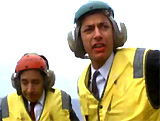
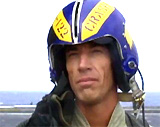
Two NASA Officials Meeting With and Recruiting Alan Shepard (Scott
Glenn) on Aircraft Carrier
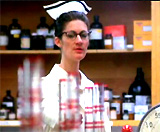
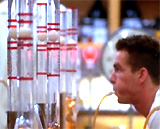
The Lung Capacity Endurance Test Conducted by Nurse Murch
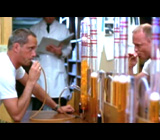
The Two Winners
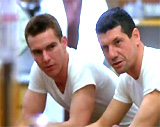
Losers: Grissom to Cooper: "We were competing with Archie and Jughead"


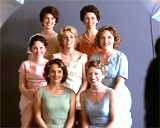
NASA's Publicity Campaign for 7 Mercury Program Astronauts (and Their
Wives)
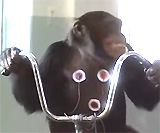
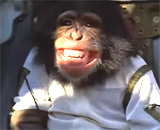
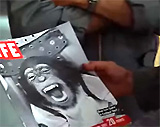
Earliest Test Flights - With a Chimpanzee

Shepard (After Peeing in His Spacesuit): "Light this
candle!"


Alan Shepard's Flight Into Space


John Glenn's Harrowing Re-Entry With Faulty Heat Shield
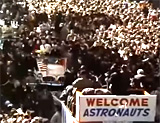
The Ticker-Tape Parade After John Glenn's Space Flight
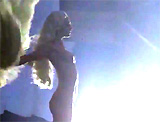
Sally Rand's Feather Strip-Tease Dance
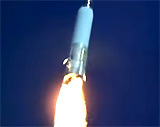
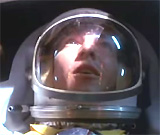

Film's Ending: Gordo's Flight in May, 1963
|


























